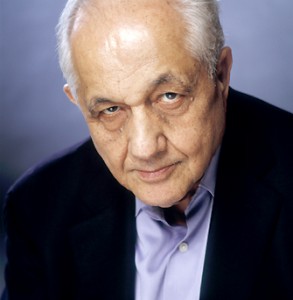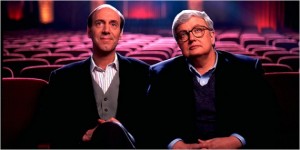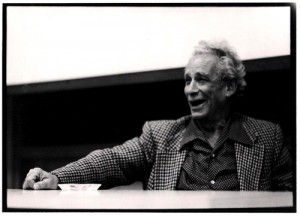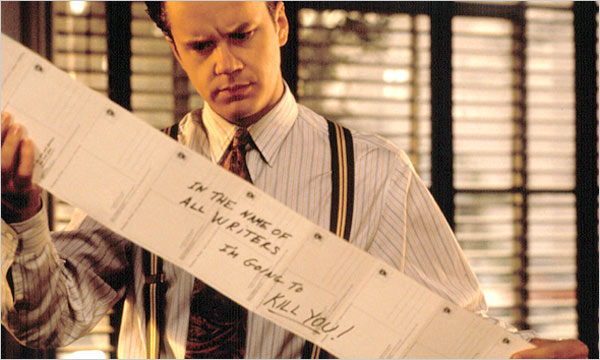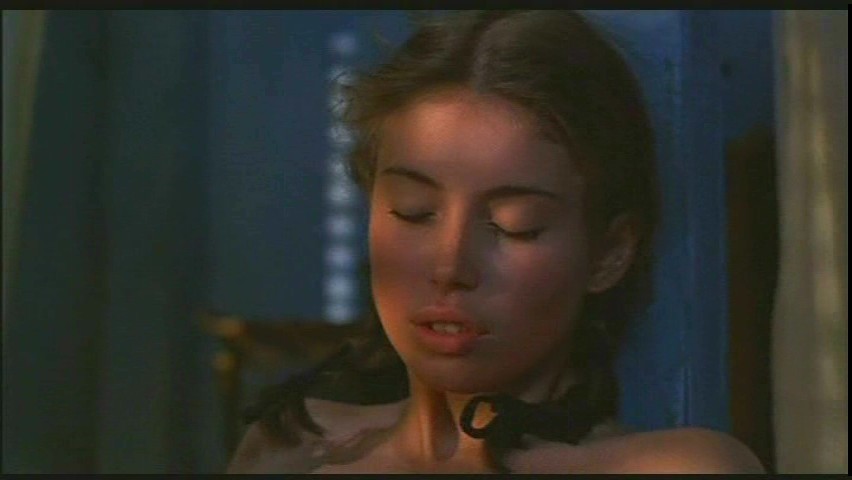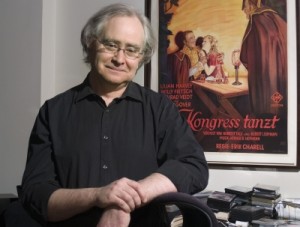From Felix (published by the European Film Academy) no. 5, 25 November 1994, where it appeared both in English and in German translation, as part of a special section called “The Vanishing Critic”. That title seems prescient in some respects; in many other ways, however, this whole piece seems very dated now. –- J.R.
One factor in particular seems to distinguish the situation of film critics in the United States from the situation of film critics elsewhere: that for the past twenty years or more, many of them have been treated like stars. This isn’t to say that the same syndrome hasn’t appeared elsewhere in different forms. During the last year or so of his life, the late Serge Daney achieved a kind of celebrity in France that is certainly related to stardom. But the notion of the intellectual star critic — the sort of fame that has accompanied European figures such as Sartre, Barthes, and Eco, and which formed Daney’s late career to a lesser extent — is not readily translatable into a stateside context, apart from a handful of figures mainly identified in the U.S with Europe, such as Gore Vidal and Susan Sontag.
What I’m thinking of, rather, are two separate kinds of star status achieved by American film critics since the 1970s. The first kind, most noticeably achieved by Pauline Kael and Andrew Sarris — who started out as intellectual critics writing for specialized publications before achieving mainstream reputations — is associated with the establishment of critical schools of thought, defining particular styles and approaches that many other critics have followed. The second kind — more recent and, alas, vastly more influential — is the ascendancy of the TVfilm reviewer.
To my mind, both kinds of stardom have had lamentable consequences on American film criticism, for different but related reasons. While both the auteurism of Sarris and the eclectic and irreverent brio of Kael made many positive and lasting contributions to American film criticism, the tendency to regard both of them as stars tended to limit the stylistic and critical options of other serious writers wishing to follow in their footsteps, thereby undermining the possibilities of a critical community that could pool its own resources. It’s also worth adding that the intellectual interests of both Sarris and Kael tended to wane as their readerships grew. Factionalism and competitiveness tended to dominate more often than constructive debates, and as the disciples of both critics gradually attained more prominent positions, what one witnessed more and more was less a complex battle of ideas than a simple scrambling for jobs.
During the mid-70s, when I was working for the British Film Institute, I was struck by the amiable opinion-swapping and theory-swapping that used to take place after evening press shows in London, when drinks and hors d’oeuvres were commonly served after the screenings, and critics were in effect encouraged to linger and discuss the films they’d just seen — a situation that one most often finds at film festivals. On a visit to New York during this period, I recall asking a prominent American critic why such gatherings weren’t held in New York. His response was swift and emphatic: “You can’t talk about a film right after you’ve seen it — other critics will steal your ideas!”
It was hard to explain to him that in London, where ideas are less likely to be seen as private property, critics are often delighted if their ideas are stolen, because this means that their ideas have power. In New York, only the critics are supposed to have power, and the ideas have to fend for themselves. This creates a different notion of criticism, a different notion of community, and a different notion of ideas. It may also help to explain why, at the moment an American critic becomes a star, the critical discourse often becomes, in effect, a nightclub act. To be a star means to have an aura, and in media ruled so brutally by the marketplace, auras are strictly personal possessions not to be shared.
What seems most ironic about this is such auras always depend more on institutional bases than they do on ideas, expertise, or even personalities. As the filmmaker Samuel Fuller once put it to me with characteristic bluntness and lucidity, “If Vincent Canby got fired from the NEW YORK TIMES today, and he went to a bar and started talking about a movie he’d just seen, nobody there would give a fuck what he thought. They’d probably just tell him to shut up.” Regrettably, the same rules often appear to function in relation to academic film criticism, and the mutual lack of interest or understanding shown between most mainstream and academic film critics reduces the possibility of a single intellectual community still further. Whereas London and Paris both benefit from having their film production centers and their intellectual centers within hailing distance of one another, the rift between Hollywood and New York is not merely one between institutions but one between discourses and separate vocabularies, and the same can be said for academic film study and mainstream film criticism.
To grossly oversimplify. Hollywood discourse is geared toward production, New York discourse is geared toward consumption, and academic discourse – which can’t be pinpointed geographically to the same degree, with major enclaves located on both coasts, in the Midwest, and elsewhere -– is geared toward analysis. And the degree to which all three discourses are allowed or encouraged in American culture is usually minimal; In recent years, one should note, the discourse of production has begun to enter and thereby alter the discourse of consumption — a development spearheaded by mass-circulation magazines purporting to give insider looks at the film business (e.g., PREMIERE, ENTERTAINMENT WEEKLY, MOVIELINE) and even certain movies that cater to the same tastes (e.g., THE PLAYER, THE BUDDY SYSTEM) — with the result that once-arcane industry terms such as turnaround, development, and points have entered the discourse, assuming at least as much importance as more aesthetic terms such as auteur and mise en scène used to have during the 70s. This is one sign among many that the industry itself and its own special concerns currently dictate and control most of the operations and emphases of film reviewing.
In the case of TV reviewing, one should note, it is the institution of national TV itself, rather than any specific network or sponsor, that establishes the aura in question. Significantly, at the present moment in the United States, the two best known and most powerful critics, who sit opposite each other every week on the same half-hour show, have reputations that are almost totally unconnected with their ideas, their critical approaches, or their degrees of expertise, and are almost entirely a function of their personalities as TV stars. One of them is a genuine film lover who is reasonably informed about the history and diversity of the medium, and the other one has practically no interest in film at all apart from his weekly professional duties. But given the overall format of their show, the general public has no way of knowing which of these men is committed to film as a general principle and which is an alienated worker; their expertise or lack of expertise becomes almost completely extraneous to their activity.
The same thing, alas, applies to most mainstream film criticism currently being published in North America. With very few exceptions, knowledge of films is almost never considered a positive criterion by magazine and newspaper editors looking for a film critic to hire; indeed, the usual assumption is that too much display of such knowledge will alienate readers and advertisers alike. (At the Toronto Film Festival every year, the slogan advertising the audience award for the most popular film is, “Because everyone’s a critic.” The democratic idea behind this phrase is infinitely more influential over North American film culture than any notion of demonstrable expertise, which is invariably regarded as snobbish and elitist.)
Daney himself understood this tendency quite well when be reviewed THE LOVER shortly before his death: “The media no longer ask those who know something (or love something or, worst of all, know why they love something) to share that knowledge with the public. Instead, they ask those who know nothing to represent the ignorance of the public and, in so doing, to legitimize it. To ‘speak for others’ always comes down to claiming droit de seigneur over their ignorance.” Daney, of course, was writing in France, which suggests that the problem I’m discussing is in no way peculiar to either North America or the U.S. in particular. But it’s none the less worth stressing that the dominance of Hollywood over the world market is nowhere more apparent today than it is in the American media, where the invasion of entertainment news (i.e., unacknowledged advertising) has become so monolithic that it conceivably occupies more broadcast time at the moment than any other kind of news. This is an invasion, moreover, that invariably marginalizes film criticism to the point where it becomes a minor offshoot and facet of multi-million-dollar publicity campaigns, and not, in most cases, any sort of alternative to those campaigns.
The sad fact is that the average American moviegoer can’t often distinguish between most film advertising and most film commentary -– and given the quality and nature of that commentary, there is no reason why any attempt to distinguish the two should be made. After all, a central criterion for success among most members of my profession is to find snippets of one’s prose reproduced in the ads themselves. (ln the U.S, there are even some reviewers quoted in movie ads who don’t bother to see the films they honor with their superlatives; they farm this drudge work out to various assistants, then compose their quotable catchphrases on the basis of their assistants’ reports.) And most reviewers for mass-circulation newspapers are expected by their editors to interview stars and directors as integral parts of their work — in other words, to produce part of the film’s publicity campaigns by other means.
As additional incentives, studio junkets become a major factor in organizing and controlling such interviews: journalists are flown to other cities, booked into plush hotel rooms, served expensive meals, and then ushered into the presence of the actors and directors to gather their promotional materials. If they wind up writing a review as well, positive or negative, this is unlikely to register in the public consciousness with much more prominence than a footnote to the surrounding hype. This helps to explain why the National Society of Film Critics, unlike many similar organizations elsewhere in the world, is a group composed non-democratically, through a process of nomination and election, rather than an organization anyone can join. If the NSFC were open to all comers, there is little doubt that most of its members would not be critics in the usual sense at all, which would defeat many of the organization’s major objectives.
Indeed, with few exceptions, reviewers for mass-circulation publications are not free to give extended attention to films that are unaccompanied by large publicity campaigns, at least on a regular basis. I count myself unusually fortunate in this regard, because I write for a free Chicago weekly that doesn’t dictate what I devote my extended critical columns to, as long as the film in question is currently running in Chicago. This means that I can wait a few weeks after a commercial film opens and write at considerable length about films that aren’t reviewed at all in magazines such as TIME, NEWSWEEK, and THE NEW YORKER; if I ignore Hollywood pictures for weeks at a time, my editor may nudge me to deal with one of the more popular pictures for a change.
By and large, the (limited) power of print reviewers to influence public tastes is a function of where they’re located, geographically as well as institutionally. Critics based in Manhattan tend to have the most clout, not only because they comprise the bulk of those who write for national publications, but also because, when it comes to most films without multi-corporate backing, distributors often take the New York reviews as cues regarding when (or whether) their films should open elsewhere. What makes this state of affairs particularly unfortunate is that New York film critics tend to be more aesthetically conservative and uninformed about the history of the medium than many of their counterparts in other cities, although the recent arrivals on the New York scene of Dave Kehr (formerly critic for the CHICAGO TRIBUNE, now writing for the NEW YORK DAILY NEWS and Godfrey Cheshire (now writing for the NEW YORK FREE PRESS, an alternative weekly) have improved this situation somewhat. After New York, Los Angeles, Chicago, Washington, D.C., and San Francisco are probably the most advantageous cities for film critics to work in, both in terms of the spectrum of films they’re able to see and the potential influence their opinions and ideas are likely to have.
A few final points should be made about press screenings and the determination of which films get reviewed. For the most part, so-called major releases are screened for the daily and weekly press three or four days before they open, although certain features receive earlier screenings for reviewers on monthly film magazines or because the distributors either want to test responses or begin word-of-mouth campaigns. When negative critical responses are feared, distributors sometimes decline to hold press screenings at all, or else (at least in the Chicago area) invite reviewers to public screenings in the suburbs. In a few extreme cases, reviewers who incur the displeasure of producers, directors. or publicists for one reason or another are barred from certain advance screenings.
In the cases of foreign and/or independent films without multinational backing, which are usually previewed by a smaller number of critics, sometimes the same rules hold, but most often video copies are sent to potential reviewers or else special arrangements are made for individual screenings. On alternative papers such as my own, the choice of what to review is generally left up to the critic, but in newspapers and magazines with a more mainstream readership, the usual expectation is that reviewers will concentrate on the major releases, regardless of their relative quality or interest.





